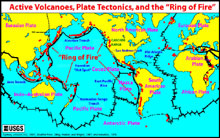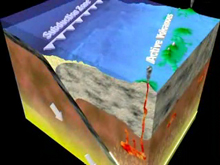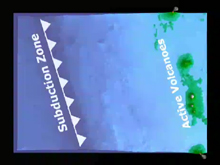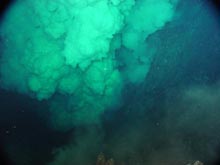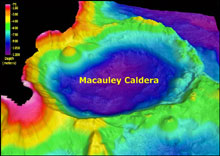 | |||
|
|
Arc Volcanism The Ring of Fire The "Ring of Fire" is a circular arc of active volcanoes that surrounds the Pacific Ocean basin. Much is known about the volcanoes on land within the Ring of Fire (for example, in the Aleutians, the Cascades, the Andes, etc), but comparatively little is known about the submarine volcanoes, simply because they are more difficult to observe. This expedition will explore, for the first tim,e some of the submarine volcanoes within the Ring of Fire north of New Zealand. Volcanoes and Plate Tectonics The Earth is covered with tectonic plates that are in constant motion over the partially-molten interior. Almost all the volcanoes and earthquakes on Earth occur near the boundaries of these tectonic plates. Where tectonic plates are moving toward each other and colliding, one plate is forced under the other in a process called "subduction".
At subduction zones, the down-going plate dives back into the Earth and is eventually melted and recycled. This process causes molten rock to rise back up to the surface to feed chains of active volcanoes called "volcanic arcs". Volcanic arcs can be on land or underwater, or can be a combination of islands and submarine volcanoes, like the Kermadec Arc. The Kermadec Volcanic Arc The Kermadec Arc is located in the southwestern Pacific, north of New Zealand. Over the past several years, international expeditions to the Kermadec Arc have found that over half of the submarine volcanoes surveyed are hydrothermally active. This year we will make dives to the seafloor to explore seafloor hotsprings on some of these active submarine volcanoes. On land, arc volcanoes tend to have explosive eruptions because the magma they erupt is relatively viscous and contains lots of gases. When the magma rises to the surface and the pressure is reduced these gases often escape explosively, much like what happens when a champagne bottle is uncorked. Until recently, it was thought that explosive eruptions in the deep ocean should be prevented by the high pressure from the overlying ocean. However, recent evidence from the Kermadec arc and elsewhere has shown this is not the case. In fact, we witnessed submarine eruptive activity at a submarine volcano for the first time during an expedition to the Mariana Arc in 2004.
Many of the submarine volcanoes in the Kermadec Arc are large calderas. Calderas are huge craters that are created when so much material is expelled from a volcano during a large explosive eruption that the top of the volcano collapses back on itself. Crater Lake in Oregon is an example of a volcanic caldera on land that formed during a huge eruption about 7000 years ago. Thus the existence of large submarine calderas in the Kermadec Arc is clear evidence that these volcanoes have a very violent past. |
||||||||||||||||










